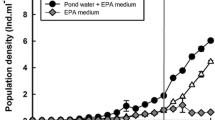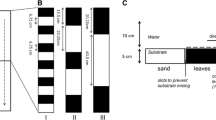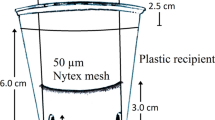Abstract
Using population densities and growth rates as criteria, we studied interactions between the epizoic rotifer Brachionus rubens and each of three cladoceran species differing in size and reproductive rates — Daphnia carinata, Moina macrocopa and Ceriodaphnia rigaudi. In all mixed — species experiments, B. rubens existed in both the epizoic mode, attached to the cladoceran host, and in the free-swimming mode. Rotifer population growth rates were significantly depressed in the presence of M. macrocopa, presumably as a consequence of exploitative and interference competition. The largest cladoceran, D. carinata probably did not suppress B. rubens, because the epizoic component of the rotifer population escaped from the deleterious effects of mechanical interference. Peak population numbers and initial population growth rates reached by all three cladocerans were lower in the presence of B. rubens, probably because of the adverse effects of the epizoic infestation, which was maximal on D. carinata and least on C. rigaudi. In mixed-species cultures of D. carinata and M. macrocopa, the presence of B. rubens helped D. carinata coexist with M. macrocopa, which otherwise would have suppressed the Daphnia.
Similar content being viewed by others
References
Burns, C. W. & J. J. Gilbert, 1986. Direct observations of the mechanisms of interference between Daphnia and Keratella cochlearis. Limnol. Oceanogr. 31: 859–866.
Gilbert, J. J., 1987. The Polyarthra escape response: Defence against interference from Daphnia. In L. May, R. Wallace & A. Herzig (eds), Rotifer Symposium IV. Developments in Hydrobiology 42. Dr W. Junk Publishers, Dordrecht: 235–238. Reprinted from Hydrobiologia 147.
Gilbert, J. J., 1988a. Suppression of rotifer populations of Daphnia: A review of the evidence, the mechanisms, and the effects on zooplankton community structure. Limnol. Oceanogr. 33: 1286–1303.
Gilbert, J. J., 1988b. Susceptibilities of ten rotifer species to interference from Daphnia pulex. Ecology 69: 1826–1838.
Gilbert, J. J., 1989. The effect of Daphnia interference on a natural rotifer and ciliate community: Short term bottle experiments. Limnol. Oceanogr. 34: 606–617.
MacIsaac, H. J. & J. J. Gilbert, 1989. Competition between rotifers and cladocerans of different body sizes. Oecologia 81: 295–301.
May, L., 1989. Epizoic and parasitic rotifers. In C. Ricci, T. W. Snell & C. E. King (eds), Rotifer Symposium V. Developments in Hydrobiology 52. Kluwer Academic Publishers, Dordrecht: 59–67. Reprinted from Hydrobiologia 186/187.
Schneider, D. W., 1990. Direct assessment of the independent effects of exploitative and interference competition between Daphnia and rotifers. Limnol. Oceanogr. 35: 916–922.
Author information
Authors and Affiliations
Rights and permissions
About this article
Cite this article
Iyer, N., Ramakrishna Rao, T. Effect of the epizoic rotifer Brachionus rubens on the population growth of three cladoceran species. Hydrobiologia 255, 325–332 (1993). https://doi.org/10.1007/BF00025855
Issue Date:
DOI: https://doi.org/10.1007/BF00025855




